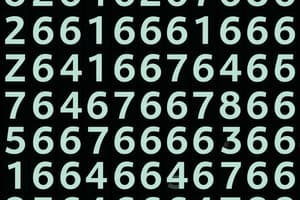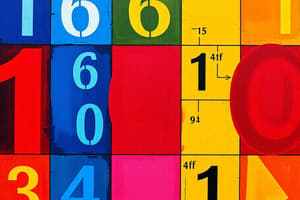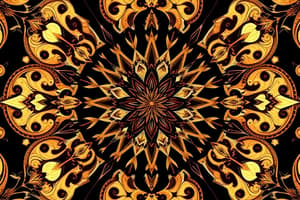Podcast
Questions and Answers
What is the primary aim of mathematics as mentioned in the content?
What is the primary aim of mathematics as mentioned in the content?
- To find existing patterns only
- To search for patterns and explain why they exist (correct)
- To create new patterns
- To solve complex equations
Mathematics is only a science and does not involve creativity.
Mathematics is only a science and does not involve creativity.
False (B)
Name one application of understanding patterns in motion.
Name one application of understanding patterns in motion.
Developing the theory of gravitation.
Mathematics recognizes patterns in everyday life, such as in ________ and ________.
Mathematics recognizes patterns in everyday life, such as in ________ and ________.
Match the applications with their respective patterns in mathematics:
Match the applications with their respective patterns in mathematics:
Which of the following exemplifies the creative aspect of mathematics?
Which of the following exemplifies the creative aspect of mathematics?
Understanding patterns in genomics has no impact on health and disease.
Understanding patterns in genomics has no impact on health and disease.
What role does creativity play in the study of mathematical patterns?
What role does creativity play in the study of mathematical patterns?
Which of the following is an example of an even number sequence?
Which of the following is an example of an even number sequence?
The sequence 1, 2, 3, 5, 8, 13, 21, ... is known as the sequence of triangular numbers.
The sequence 1, 2, 3, 5, 8, 13, 21, ... is known as the sequence of triangular numbers.
Name one way mathematics has helped humanity in everyday life.
Name one way mathematics has helped humanity in everyday life.
The branch of Mathematics that studies patterns in whole numbers is called __________.
The branch of Mathematics that studies patterns in whole numbers is called __________.
Match the following number sequences with their names:
Match the following number sequences with their names:
Which number sequence starts with 1 and includes numbers obtained by adding the previous two?
Which number sequence starts with 1 and includes numbers obtained by adding the previous two?
Mathematics is unnecessary for constructing buildings.
Mathematics is unnecessary for constructing buildings.
What are cubic numbers?
What are cubic numbers?
What is the next number in the sequence of powers of 2: 1, 2, 4, 8, 16, 32?
What is the next number in the sequence of powers of 2: 1, 2, 4, 8, 16, 32?
The sequence 1, 3, 9, 27 represents the powers of 2.
The sequence 1, 3, 9, 27 represents the powers of 2.
What is the rule for forming even numbers in a number sequence?
What is the rule for forming even numbers in a number sequence?
The sequence of odd numbers starts from 1 and follows the rule of adding _____ to each previous number.
The sequence of odd numbers starts from 1 and follows the rule of adding _____ to each previous number.
Match the following types of number sequences with their definitions:
Match the following types of number sequences with their definitions:
Which of the following sequences is represented by 1, 4, 9, 16, 25?
Which of the following sequences is represented by 1, 4, 9, 16, 25?
Visualizing number sequences can aid in understanding mathematical patterns.
Visualizing number sequences can aid in understanding mathematical patterns.
Provide the first three numbers of the cube number sequence.
Provide the first three numbers of the cube number sequence.
In the sequence of counting numbers, the next number after 5 is ____.
In the sequence of counting numbers, the next number after 5 is ____.
What do triangular numbers represent?
What do triangular numbers represent?
Flashcards
Number sequences
Number sequences
Ordered lists of numbers following a specific pattern.
Number theory
Number theory
The branch of mathematics that studies patterns in whole numbers.
Whole numbers
Whole numbers
Numbers that are non-negative and do not include fractions or decimals.
Odd numbers
Odd numbers
Signup and view all the flashcards
Even numbers
Even numbers
Signup and view all the flashcards
Triangular numbers
Triangular numbers
Signup and view all the flashcards
Squares
Squares
Signup and view all the flashcards
Cubes
Cubes
Signup and view all the flashcards
Mathematics as Pattern Finding
Mathematics as Pattern Finding
Signup and view all the flashcards
Explanations for Patterns
Explanations for Patterns
Signup and view all the flashcards
Applications of Patterns
Applications of Patterns
Signup and view all the flashcards
Patterns in Nature
Patterns in Nature
Signup and view all the flashcards
Mathematical Creativity
Mathematical Creativity
Signup and view all the flashcards
Scientific Usefulness of Patterns
Scientific Usefulness of Patterns
Signup and view all the flashcards
Powers of 2
Powers of 2
Signup and view all the flashcards
Powers of 3
Powers of 3
Signup and view all the flashcards
Number Sequence
Number Sequence
Signup and view all the flashcards
Visualizing Number Sequences
Visualizing Number Sequences
Signup and view all the flashcards
Pictorial Representation
Pictorial Representation
Signup and view all the flashcards
All 1's
All 1's
Signup and view all the flashcards
Counting numbers
Counting numbers
Signup and view all the flashcards
Odd numbers
Odd numbers
Signup and view all the flashcards
Even numbers
Even numbers
Signup and view all the flashcards
Triangular numbers
Triangular numbers
Signup and view all the flashcards
Square numbers
Square numbers
Signup and view all the flashcards
Cube numbers
Cube numbers
Signup and view all the flashcards
Study Notes
Patterns in Mathematics
- Mathematics is largely the search for patterns and their explanations
- Patterns exist in nature, homes, schools, and various aspects of life
- Mathematics is both an art and a science, emphasizing creativity and artistry
- Explanations for patterns are as important as the patterns themselves
- Discovered explanations can be applied in various contexts to advance humanity
Patterns in Numbers
- Number sequences are fundamental
- Whole numbers (0, 1, 2, 3, ...) exhibit various patterns
- Number theory studies patterns in whole numbers
- Number sequences are crucial and fascinating
- Visualizing number sequences via diagrams aids in understanding patterns
Visualizing Number Sequences
- Visual representations, like pictures or diagrams, greatly enhance understanding of mathematical patterns.
- Number sequences are visualized through various pictorial examples
- Understanding patterns is assisted through pictorial representations
- This is a valuable method facilitating comprehension of mathematical concepts.
Relationships Among Number Sequences
- Number sequences often exhibit surprising relationships
- Patterns emerge when adding or multiplying sequences.
Relations Among Number Sequences (Example)
- Adding consecutive odd numbers results in a perfect square.
- Visualizing with a picture helps understand the phenomenon that adding odd numbers yields square numbers
Relations Among Number Sequences (Example Continued)
- Square numbers are formed by counting dots in a square grid.
- Odd numbers (1, 3, 5, ...) can be used to partition the dots in a square grid in a way that represents a pattern.
- The given pattern is that adding up odd numbers gives perfect square numbers.
Patterns in Shapes
- Patterns in shapes is an important branch of mathematics (geometry).
- Shapes can be 1D, 2D, or 3D
- Key examples include polygons, complete graphs and other sequences
Relations to Number Sequences
- Shape sequences have surprising links with number sequences
- The number of sides in each polygon (shapes) forms a number sequence (3, 4, 5…)
- Relationships between shapes and numbers provide deeper understanding
- These connections further enhance both shape and number sequence understanding
Points, Lines, Rays, and Angles
- Points denote a location (no length, breadth or height)
- A line segment has two endpoints
- A line extends indefinitely in two directions
- A ray starts at a point and extends indefinitely in one direction
- An angle is formed by two rays sharing a common endpoint (vertex)
Angles and Their Types
- Angles can be classified by their degree measures (e.g., acute, right, obtuse, straight, reflex):
- An acute angle is less than 90°.
- A right angle is 90°.
- An obtuse angle is greater than 90° but less than 180°.
- A straight angle is 180°.
- A reflex angle is greater than 180° but less than 360°.
Measuring Angles
- Angles can be measured using a protractor.
- The protractor measures angles in degrees (a unit).
- The full circle has 360°.
- Half a circle has 180 degrees.
Special Types of Angles
- A straight angle is formed when two rays extend in a straight line.
- A right angle is half of a straight angle.
Comparing Angles
- Angles can be compared using superimposition (one angle placed over another).
- Angles can also be compared by considering the amount of rotation that is needed for one ray to coincide with the other ray.
- Identifying the arms and vertex of the angles aids in visualizing and comparing them
Drawing Angles
- Angles can be drawn using a protractor.
- Protractors are used to measure and construct angles
Playing Games with Numbers
- Number games are effective ways to understand numbers, mathematical operations and patterns.
- Games like 21 etc., involving adding numbers to certain sums, can help to explore number patterns
Patterns of Numbers
- Number lines provide visual representations of numbers and their relative values.
- Numbers are arranged in patterns, often following a sequence
- Using the patterns allows for quicker analysis and problem solving.
Digit Detectives
- Investigating the frequency of digits within a sequence of numbers
- Exploring the underlying patterns and their implications
Palindromic Patterns
- Palindromes are sequences of numbers that read the same forwards and backwards
- There are many examples found in different numerical categories, and sequences in nature
- The rules and patterns around palindromes yield an investigation of patterns
Prime Factorization
- Every number greater than 1 can be written as the product of primes.
- Listing out prime and composite numbers
- Identifying the common factors between numbers to determine co-prime numbers
Divsibility Tests
- Various divisibility rules can simplify calculations and help quickly identify the factors of larger numbers
- Determining factors of a number with specific last digit or digits provides shortcuts
- Recognizing patterns to determine divisibility is a simpler approach
The Collatz Conjecture
- An unsolved problem in number theory concerning a sequence of numbers
- The rule is to keep applying a particular set of algebraic operations to a given number, eventually ending up at 1
- Investigating sequences where a number may approach 1 but seemingly never entirely reaches or arrives at a 1.
Data Handling and Presentation
- Data collection: Gathering information, measures, observations, and facts
- Organizing data: Organizing and arranging collected data in various formats like tables or lists
- Visual data representations: Communicating data using diagrams or graphs to allow for quick interpretation and identification of patterns
- Pictographs, Bar graphs are different representations allowing for visualization and quick understanding of the data
- Importance of visuals to represent data: enhancing clarity, efficiency, making interpretation and communication easier
- Data visualisations: including bar graphs, pictographs etc. are important tools to allow easier understanding and provide more attractive presentations
Studying That Suits You
Use AI to generate personalized quizzes and flashcards to suit your learning preferences.




